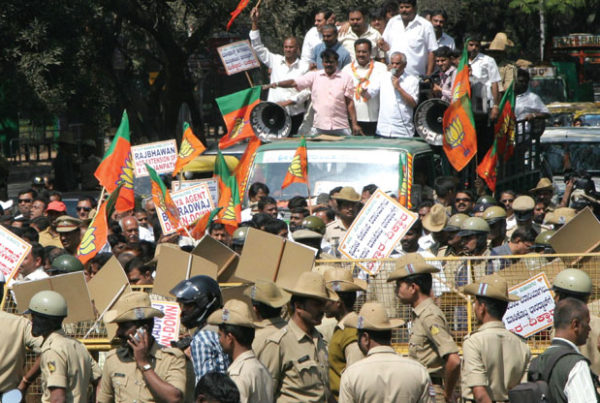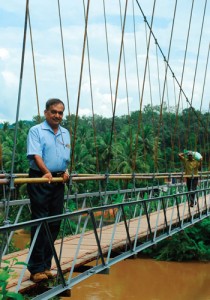Karnataka chief minister BS Yeddyurappa has promised investors the moon, without giving a thought to their infrastructure needs, says Sanjana
IT WAS a numbers game all through. When the Global Investors’ Meet (GIM) concluded in Bengaluru last week, Karnataka Chief Minister BS Yeddyurappa was all smiles: he believed he had impressive numbers to share and global industrialists alongside as he announced them. Over two days, the Karnataka government signed 353 Memorandum of Understanding (MoUs) — said to be a record for the state — with global giants such as ArcelorMittal, the Pohang Iron and Steel Company (POSCO) and homegrown giants such as the UB group, Aditya Birla, Infosys and Wipro among others. The MoUs brought in investment proposals worth Rs 4 lakh crore, said the Chief Minister, surpassing the government’s expectation of Rs 3 lakh crore. A second later, even as he struggled for breath, he added, “The total employment potential from this investment is a record 8.65 lakh.” There were no questions following the announcements; no challenges to the numbers.
Hours later, the first hint that the story didn’t end with the Chief Minister’s numbers came interestingly from a key cabinet minister in a local television studio. In the company of an overly enthusiastic journalist, the Large and Medium Industries Minister Murugesh Nirani admitted that it would be a surprise if even 50 per cent of the announced projections translated into projects. MoUs, he added, are after all expressions of interest. To ensure conversions of the big ticket investment proposals, the government would have to satisfy the infrastructural demands including land and electricity. Despite the Chief Minister’s insistence that these are not difficult demands for the state to satisfy, the reality is something else.
In May 2010, a month before the GIM, Yeddyurappa, while addressing a conference in New Delhi, had talked of the state’s severe power shortage. Pegging the demand-supply gap at 22 percent, he talked of annual load growing at a rate of 8-10 percent. If all the envisaged power projects perform at projected outputs, Karnataka could expect to be power sufficient in five years, Yeddyurappa had said. Currently, several parts of rural Karnataka receive only 4-6 hours of electricity — mostly during the night. A situation that is bound to get worse if even a third of the proposals promised during GIM are realised. In response to questions raised on the issue, the government talked of the investments in the power sector during GIM. One of the biggest MoUs signed in the power sector was with Pune-based Bharat Forge. The Kalyani group has promised investments to the tune of Rs 3,150 crore in two power plants in the state. Ask further if there is enough power to support the establishment of the plants, and there are no concrete answers.
Janardhana Reddy is unfazed by the legal cases relating to mining irregularities in Bellary
The sector that attracted the maximum number of investment proposals at GIM was expectedly iron and steel. Lakshmi Mittal, Chairman and CEO of the world’s largest steel conglomerate, ArcelorMittal, signed an MoU with the government and promised a Rs 30,000 crore investment. The steel giant plans to establish a six-million- tonnes-per-annum integrated steel plant in Bellary. Supporting the project will be an ancillary power plant that will look to generate 750 mw. Courted by both the government and the media, Mittal expectedly exuded confidence in the Karnataka government’s ability to accord all necessary clearances. Dismissing the problems faced by the company in Jharkhand and Orissa — public protests, lack of environmental clearances have stalled ArcelorMittal’s projects — Mittal talked of the Karnataka government ensuring that the plant would be operational in 36 months from the time the foundation stone was laid. He, however, admitted to not possessing a mining lease. “We are in the process of working with the government to obtain one,” said Mittal. A minute later, the industrialist agreed that the state government’s role was restricted to recommending companies for mining leases. The ultimate decision rested with the Central government. And no, a mining site had not been located either — though Bellary was a likely one.
The biggest investment in the steel sector was, however, promised by the Karnataka Tourism Minister and Bellary mining baron, Janardhana Reddy. Brahmani Steels, promoted by Reddy and his brothers, signed an MoU worth Rs 36,000 crore with the Karnataka government. Unfazed by the number of legal cases relating to mining irregularities, Reddy talked excitedly of the MoUs signed by his wife on behalf of the company: they would set up another steel plant in the district.
There were several other projects in the pipeline — a heli-tourism project that promises tourists an aerial ride of Karnataka’s heritage sites; 18 airports in the next 13 months; and expansion plans by software giants Infosys and Wipro. Clearly, ambition was not in short supply.
But if numbers are the way to tell the story, there is a different set of statistics that could be used. According to the Department of Industrial Policy and Promotion, a Central government department, the total foreign direct investment approved in Karnataka between 2000 and 2010 was around Rs 30,000 crore. The actual amount invested fell further short. In light of this, what do the numbers touted by the Karnataka government after the Global Investors’ Meet mean?
- The Karnataka Government Signed A Record 353 Agreements With Indian And Global Giants
- Deals Worth Rs 400,000 Crore Were Inked By The Government, Promising 8.65 Lakh Jobs
- The Deals Are Mostly Expressions Of Interest, Says Industries Minister M Nirani
- The Arcelormittal Plant Will Go On Stream In Three Years But The Group Has No Mining Lease
- Mining Baron Janardhana Reddy Signed The Largest Investment In Steel For Rs 36,000 Crore
—
This article was originally published in Tehelka, a leading independent news magazine in India, known for its investigative journalism.



